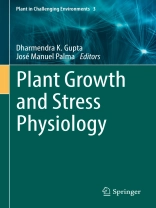This book aims to emphasize on basic concepts of plant growth, acclimation, and their adaptation to environment in changing conditions. The book will provide an updated perspective on the physical/mechanical stress, including biotic and abiotic stress, and induced responses in higher plants. This volume will also include a view of the stress recognition by plants and the cell signaling events triggered as a consequence, and will also address an appraisal of the plant oxidative stress metabolism under those circumstances. The book will explore how soil minerals and microbes are affecting plant growth, including elicitors and novel compounds which stimulate plant growth and the defence mechanisms issued by plants. This volume will also cover an overview on the enzymes which may regulate plant growth, as well as the evidences of the involvement of phytohormones and other signalling molecules in plant growth.
Tabla de materias
Chapter 1. Plant stress, acclimation, and adaptation: A review (Gupta).- Chapter 2. Insights into role of invisible partners in plant growth and development (Sathishkumar).- Chapter 3. How do plants sense, respond and memorize heat stimuli? (Suzuki).- Chapter 4. From beneficial bacteria to microbial derived elicitors: biotechnological applications to improve fruit quality (Solano).- Chapter 5. Come hell or high water: breeding profile of eucalyptus tolerance to abiotic stress focusing water deficit (Toledo Picoli).- Chapter 6. Organic fertilization of fruit trees as an alternative to mineral fertilizers: effect on plant growth, yield, fruit quality and environment (Baldi).- Chapter 7. Hydrogen peroxide concentration as an indicator of abiotic oxidative stress response of invasive macophyte species Egeria densa (Asaeda).- Chapter 8. Opportunities of revegetation and bioenergy production in marginal areas.- Chapter 9. Biochar behaviour and the influence of soil microbial community (Anyanwu).- Chapter 10. New insights into the functional role of nitric oxide and reactive oxygen species in plant response to biotic and abiotic stress conditions (Barroso).- Chapter 11. Selenium transport, accumulation and toxicity in plants (Shin).- Chapter 12. Selenium in algae: Bioaccumulation and toxicity (Maronić).
Sobre el autor
Dr. Dharmendra K. Gupta is Director (S) and Scientist “F” in the Ministry of Environment, Forest and Climate Change, Government of India at New Delhi, India and already published more than 115 refereed research papers/review articles in peer reviewed journals and in books, also edited 18 books from Springer and NOVA publishers. His field of research includes abiotic stress by radionuclides/heavy metals and xenobiotics in plants; antioxidative system in plants, environmental pollution (radionuclides/heavy metals) remediation through plants (phytoremediation). According to google scholar his h-index is 37.
Prof. José Manuel Palma is Research Professor of the Spanish National Research Council (CSIC), with expertise on antioxidants and free radicals in plant systems. With more than 140 peer-reviewed research papers published, he has also been editor of five books and several special issues of a number of internationalimpact journals. At present, he is involved in the research of the interaction between nitric oxide and antioxidants during fruit ripening. He leads the research group “Antioxidants, Free Radicals and Nitric Oxide in Biotechnology, Food and Agriculture” at Estación Experimental del Zaidín (EEZ), CSIC, Granada, Spain. He was Deputy Director and Acting Director of the EEZ (CSIC) in the period 2007–2014, and invited Professor at the University of Granada.












